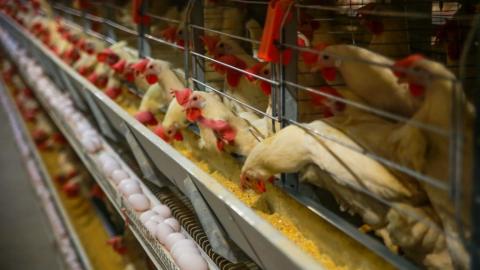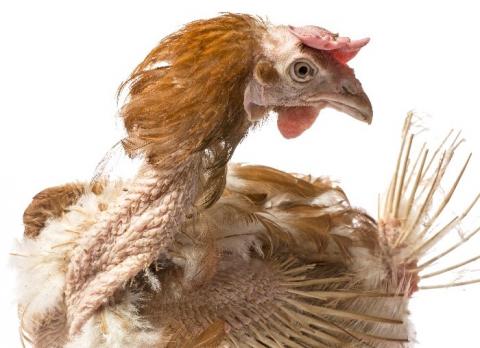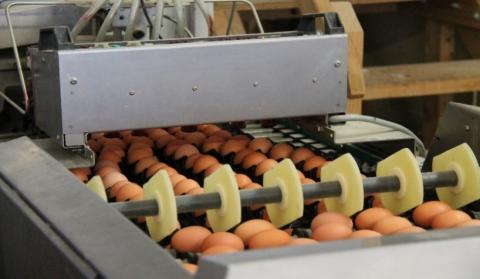6 July 2020
Dr David Cutress: IBERS, Aberystwyth University.
- The poultry industry is currently the fastest-growing meat production sector globally
- Whilst egg production is a vital source of nutrition, broiler systems have seen far more targeted innovation and development than layer systems
- Several technologies exist which could play a significant role in improving layer productivity, however, there is a lack of commercialisation of systems and evidence of their practical benefits
Introduction
As of 2018, poultry meat production was determined to be 127.31 million tonnes globally (increasing around 64% since 2005) representing the highest demand of any single animal product. In 2005 global demand for poultry eggs specifically was 62 million tonnes, this was predicted to rise by around 40% by 2050. Currently, the growth of the poultry sector as a whole, across the world, was the single highest of all meat sectors at >16% growth observerd over the past decade. As such poultry production requires continual innovation to meet increasing demands.
Whilst initial innovation was achieved, through intensification of systems, genetic manipulations, nutritional improvements and environment controls an increasing focus is being placed on animal health and welfare and individual animal level controls. Technologies are aiming to improve key aspects of the poultry industry, including layer hen welfare/productivity. This article aims to highlight key technologies that are in commercial use or could be adapted from broiler applications, and those which are in the research and development stages in this sector.
Layer and poultry systems
Recently, there has been a significant shift towards the improvement of layer hen welfare, with a ban implemented from 2012 in the EU, which eliminated non-enriched conventional cage rearing systems. Interestingly since the ban, the distribution of cage systems, in general, has decreased (figure 1), with higher uptake in free-range and barn-based system. Other practices such as beak trimming (to reduce feather pecking) have also advanced, for example, Infra-red beak trimming is now common with ongoing discussion towards banning such practice altogether. Despite advances, many regions lag behind the EU and continue to farm in lower welfare conventional cage systems. Equally, research struggles to catch up with the new norm, with the majority of precision technology development having been performed in conventional cage system settings, however, much of this information could be transferable.
Figure 1. Distribution of EU layer housing systems 2009 and 2014
Improving animal welfare and health can both, directly and indirectly, increase animal productivity in farming systems. A recent review noted a higher number of studies specifically focused on welfare, rather than improving productivity as the main goal. This review also noted, across the 266 studies included, that >40% were dedicated specifically to broiler farming whilst only 25% focused on layers and only 5% were commercially available products rather than prototypes. This suggests despite the need for innovation that current technologies are in their infancy and further development is required. Additionally, whilst systems like large-area aviaries may appear to have the highest welfare for birds, they demonstrate lower productivity in general and have been associated with increased mortality and cannibalism tendencies in some studies.
Technologies in poultry
Automation systems
Automation systems have been implemented in the poultry sector fairly significantly, with commercially available layer management systems providing; feed, egg removal, waste removal and temperature/humidity control automatically. Whilst, these are considered automated, in the sense that they are performed without human labour, many of these systems are based on arbitrary or whole flock analysis values and as such can, and are, being developed further to improve productivity. Systems such as FLOCKMAN have been introduced commercially integrating multiple variables into one controller. FLOCKMAN optimises control of feed levels and lighting with programmes tailored to improve profit margins in broilers. Fancom offers commercial automated layer systems which integrate ventilation control, feed weighing/blending, automatic egg counting, animal weighing and water monitoring along with software feedback to suggest management optimisations and improvements to achieve higher productivity.
Whilst currently not automated, the commercial systems offered by Prognostix can evaluate the conditions across a shed, or multiple sheds, including; water use, localised temperature, humidity, airflow, light intensity and carbon dioxide levels. These systems provide alerts of health or productivity losses improving farmer intervention, and in future, could be incorporated to allow automated responses.
Automation is also highly prominent in the “back end” of egg production with several commercial systems available to automate egg collecting, sorting, processing and packaging, therefore, improving the productivity and efficiency of the sector.
Precision livestock sensors
Precision sensor technologies offer a unique opportunity in poultry towards monitoring, often individual-level, animals in various ways. Whilst technologies are less evidently commercialised than in cattle, research suggests that the average growth in technology publications in the last five years has been highest in the poultry sector. There is, however, likely a lag between research development levels and active commercialisation.
Accelerometer/movement sensors have been assessed for use in poultry, with the suggested ability to detect abnormal behaviour and illness, detecting avian influenza 2 x earlier than using body temperature. Early detection can reduce infection spread, facilitate treatment and improve productivity. Sensors can also determine activity profiles with 98% accuracy across different laying hen breed profiles. In future, this could allow the reduction of injury levels in laying hens improving welfare and productivity. Within poultry, over other livestock such as cattle, initial issues in development were linked with requiring small enough technology to mount onto the animal, without causing detrimental effects. Technology can now be made smaller, even allowing the development of injectable capsules to detect movement as well as temperature and heart rate in chickens, offering a holistic monitoring approach of individual animals.
Acoustic sensors have seen significant development in the pig sector offering a useful tool to detect stress and make amendments to remove stressors. The benefit of acoustics is that monitoring is non-invasive, therefore, does not itself cause additional stress. In a study on Hyline brown layers in a conventional cage system, acoustic detection along with computer algorithms were able to detect stress and classify it between physical (temperature etc.) and mental (fear) with 96.2% accuracy. Further studies have demonstrated acoustic data can be used to detect pulmonary diseases in poultry and even to detect detrimental feather pecking in layers. The ability to detect and alert to stress and health issues within a laying system would help improve layer health and egg production.
Image analysis also offers a method of constant non-invasive monitoring. There are already commercial systems (though focused on broilers) which utilise image analysis, as well as robotic systems, including; Tibot, Octopus Robotics and Poultrybot (see below) which are all reliant on imaging sensors. Fancoms eYeNamic system allows spatial distribution of broilers to be visualised to detect abnormalities and assists in creating improved environments for productivity, this could easily be adapted to non-caged layers. Development has also been performed in using infra-red thermography to assess temperature changes in hens, towards alerting to illness and detecting feather coverage/damage. Optical flow image analysis techniques can predict flocks which will commence damaging feather pecking activities several weeks in advance, allowing controls to be put in place. In cage systems image analysis demonstrated potential in counting hens and particularly noting hen mortalities, as well as being able to detect blockages in egg belts, with removal of deceased hens being vital for welfare and hygiene. Another unique application of image-based sensors is near infra-red (NIR) reflectance which has been developed for cattle to assess contents of feeds via a handheld device. Based on previous work this could be adapted for poultry feed, improving productivity and animal health. In poultry, NIR is also a vital tool in assessing carcass quality/contamination, and has seen development in early egg sexing facilitating increased eggs entering processing. Sexing eggs is a concern due to lost time spent incubating male eggs, only to have to cull these on hatching (with ethical and welfare implications). Other sexing methods include developing genetic modifications to link male chromosomes to fluorescence. This could be performed when eggs undergo the increasingly common practice of ovo vaccinations.
Notably, the poultry sector demonstrates a high uptake of robotics. There are several commercialised poultry robotic systems available with varying functions. A driver for robotic use within poultry could be the risk of cross-species infections, as with avian influenza H5N1, which underwent significant global spread in the mid to late 2000s. Robot automation can reduce human labour and thus interaction required within hen houses, reducing infection risks both ways and improving biosecurity. Octopus robots produce autonomous robots for poultry which aerate litter and apply liquid disinfectants to reduce ammonia build-up and disease occurrence. Systems also have onboard sensors to provide information on the local temperature, humidity, ammonia levels and can record sound and brightness. The additional data can facilitate management changes to improve overall hen productivity and health. Tibot Technologies offer robotic systems for broilers, layers and breeders which act as patrol units to activate birds. Spoutnic, the unit aimed at layers, promotes nest training, therefore, lowering floor eggs by up to 26% which otherwise reduces the productivity of layer systems, and reduces farmer walkthroughs required by up to 3 times. Poultrybot is a system in current development for automated floor-egg collection. The move away from cage systems makes floor eggs an increasing area of farm labour and reduces productivity, therefore, autonomous robotic collection is of interest. Poultrybot uses image sensors and object recognition software to identify eggs and collect these autonomously whilst manoeuvring around animals and obstacles in poultry houses, currently, efficiency of this collection is 40% with small changes suggested to improve collection to 80%, in future.
Radio-frequency identification RFID is a requirement in cattle and sheep production as an identification method, however, it could have substantive roles in the poultry sector. Due to defined boundaries within hen houses, it is suggested that RFID could act as a localisation/monitoring tool, whereby communication of a passive RFID tag on the ankle of a hen with a fixed active RFID receiver could, for example, provide data that a hen had visited a feed or water station. System designs include those which could detect avian influenza, via observing reduced feed visits and movement in general. RFID could be utilised in weighing birds in nesting situations or at feeders to look at growth patterns and alert individual health concerns. Furthermore, RFID has been incorporated into a nest box system allowing for accurate detection of individual bird egg-laying statistics, offering opportunities to improve productivity by managing specific birds, or culling unproductive animals. RFID is a useful identification tool, however, lost tags could cause issues in identification. Another process of hen identification trialled was the laser printing of barcodes onto hen beaks. Whilst this was effective short term, it was shown that barcode readability dropped off significantly after 10 days suggesting this specific route to be unfeasible.
Where animal illness is concerned, several biosensors style pen-side technologies have seen development towards rapid identification and treatment of diseased birds. Lateral flow systems, which use embedded antibodies (similar to traditional pregnancy tests), have been improved using quantum dot technologies making tests more sensitive and able to work with crude samples such as faecal swabs, detecting key diseases like avian influenza. Furthermore, DNA amplification advances such as loop-mediated isothermal amplification (LAMP) are providing possibilities to test for other infections including Eimeria (a serious poultry threat) with results in 30 minutes or less.
Probiotics have been discussed as an area to improve broiler growth, layer egg output and quality, as well as general welfare in both systems. Whilst this is not a new route to improve production, increases in our understanding and ability to assess gut microbiomes could allow for improved applications of probiotics. Furthermore, probiotics could help to alleviate the antibiotic resistances associated with using antibiotics in poultry to improve productivity having a doubled effect. It is interesting to note that poultry nutrition in general has tended to focus on flock level assessments. Poultry nutrition tools are only just beginning to catch up to allow individual-bird assessments, which could, improve productivity further and reduce negative outputs as evident in other livestock systems.
A key aspect of the commercial sale of poultry eggs is the size and quality of the eggs produced. Current systems use multiple sensors to weigh, size and check eggs for defects following initial collection. It has been noted that computer vision could be used to improve systems by providing predicted weight separation based on egg. Development of this system showed high potential in separating eggs into classes from small to extra-large using non-invasive, non-physical approaches, this could, in future, be incorporated at the initial egg transportation stages within layer houses to pre-sort eggs based on size improving system productivity. Imperfections such as blood spots (of particular sizes) reduce quality criteria and thus sale prices of eggs. Technology using fibre optic spectrometry (5 wavelengths) could incorporate into conveyor belt lines, and demonstrated 95% accuracy in detecting blood spots.Pre-sorting of these less valuable eggs real-time would improve system productivity.
Farming Connect demonstration farm Wern is utilising precision monitoring systems to get a practical insight into their benefits on animal health.They are also trialing cutting edge technology towards assesing areas, post egg laying, which could be improved to reduce egg damage and further bolster productivity.
Summary
Where technologies have been employed within the poultry sector they appear to demonstrate significant benefits, however, more long term use is required to determine true effects. As the poultry industry is the fastest-growing meat sector, particularly in developing countries, innovation, chiefly affordable innovation is key. Within this article, unless specifically stated, all technologies are in research and development. Precision tools have difficulty in transitioning from prototypes to commercial systems, a key factor may be that research fails to include manufacturing companies and involves controlled, rather than commercial trials. Despite all this, technologies which allow individual animal level analysis to be performed, as well as providing automation, could provide a more lucrative, safer environment, for both the animals and farmers involved. Currently, with changes occurring revolving around welfare practices within the layer sector, it may be prudent to aim innovation at likely future system models, or to wait to determine what effects changes may have on the sector, to gain the best overall picture.



